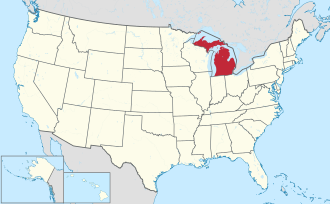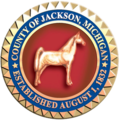Government
The county government operates the county jail, maintains township roads, operates the major local courts, keeps files of deeds and mortgages, maintains vital records, administers public health regulations, and participates with the state in the provision of welfare and other social services. The county board of commissioners controls the budget but has only limited authority to make laws or ordinances. In Michigan, most local government functions – police and fire, building and zoning, tax assessment, street maintenance, etc. – are the responsibility of individual cities and townships.
Elected officials
- Michigan State House of Representatives, State Representative District 64: Julie Alexander (R)
- Michigan State House of Representatives, State Representative District 65: Mike Shirkey (R)
- Michigan State Senate, State Senate District 17: Randy Richardville President pro tempore (R)
- Michigan State Senate, State Senate District 19: Mike Nofs (R)
- Prosecuting Attorney: Jerry Jarzynka [5]
- Sheriff: Gary R. Schuette
- County Clerk/Register of Deeds: Cierra Sowle
- County Treasurer: Karen Coffman
- Drain Commissioner: Geoffrey W. Snyder
- County Surveyor: Dean R. Gutekunst
- County Commissioners: Tony Bair District 1, Margie Walz District 2, Vice Chairman Corey Kennedy District 3, Philip Duckham District 4, Chairman James Shotwell Jr. District 5, Earl Poleski District 6, John Willis District 7, Darius Williams District 8, and Ray Snell District 9.
(information as of February 21, 2013)
Demographics
Historical population| Census | Pop. | Note | %± |
|---|
| 1840 | 13,130 | | — |
|---|
| 1850 | 19,431 | | 48.0% |
|---|
| 1860 | 26,671 | | 37.3% |
|---|
| 1870 | 36,047 | | 35.2% |
|---|
| 1880 | 42,031 | | 16.6% |
|---|
| 1890 | 45,031 | | 7.1% |
|---|
| 1900 | 48,222 | | 7.1% |
|---|
| 1910 | 53,426 | | 10.8% |
|---|
| 1920 | 72,539 | | 35.8% |
|---|
| 1930 | 92,304 | | 27.2% |
|---|
| 1940 | 93,108 | | 0.9% |
|---|
| 1950 | 108,168 | | 16.2% |
|---|
| 1960 | 131,994 | | 22.0% |
|---|
| 1970 | 143,274 | | 8.5% |
|---|
| 1980 | 151,495 | | 5.7% |
|---|
| 1990 | 149,756 | | −1.1% |
|---|
| 2000 | 158,422 | | 5.8% |
|---|
| 2010 | 160,248 | | 1.2% |
|---|
| 2020 | 160,366 | | 0.1% |
|---|
| 2024 (est.) | 160,233 | [7] | −0.1% |
|---|
|
As of the census [12] of 2000, there were 158,422 people, 58,168 households, and 40,833 families residing in the county. The population density was 224 people per square mile (86 people/km2). There were 62,906 housing units at an average density of 89 per square mile (34/km2). The racial makeup of the county was 88.54% White, 7.92% Black or African American, 0.40% Native American, 0.53% Asian, 0.04% Pacific Islander, 0.83% from other races, and 1.74% from two or more races. 2.20% of the population were Hispanic or Latino of any race. 24.3% were of English, 21.7% of German, 11.5% American, 9.9% Irish and 8.1% Polish ancestry according to the 2012 American Community Survey. 95.9% spoke only English at home, while 2.1% spoke Spanish.
There were 58,168 households, out of which 33.50% had children under the age of 18 living with them, 53.80% were married couples living together, 12.00% had a female householder with no husband present, and 29.80% were non-families. 24.60% of all households were made up of individuals, and 9.60% had someone living alone who was 65 years of age or older. The average household size was 2.55 and the average family size was 3.03.
In the county, 25.60% of the population was under the age of 18, 8.10% was from 18 to 24, 30.40% from 25 to 44, 23.00% from 45 to 64, and 12.90% was 65 years of age or older. The median age was 37 years. For every 100 females there were 104.20 males. For every 100 females age 18 and over, there were 103.70 males.
The median income for a household in the county was $43,171, and the median income for a family was $50,970. Males had a median income of $38,919 versus $26,448 for females. The per capita income for the county was $20,171. About 6.50% of families and 9.00% of the population were below the poverty line, including 12.40% of those under age 18 and 6.10% of those age 65 or over.
This page is based on this
Wikipedia article Text is available under the
CC BY-SA 4.0 license; additional terms may apply.
Images, videos and audio are available under their respective licenses.





